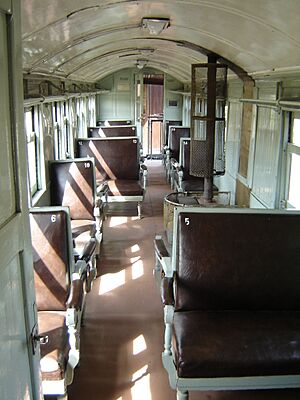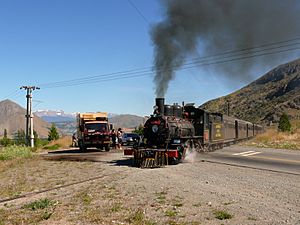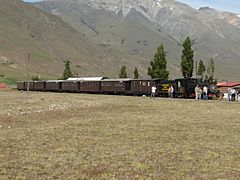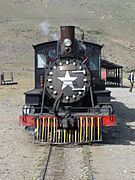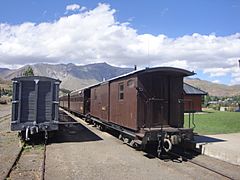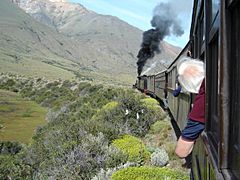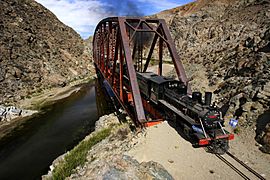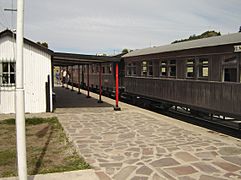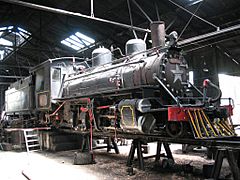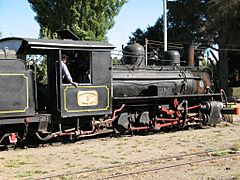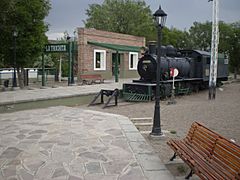La Trochita facts for kids
Quick facts for kids La Trochita |
|
|---|---|
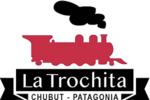 |
|
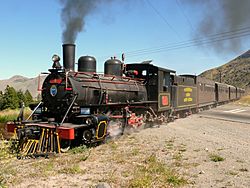
La Trochita pictured in 2010
|
|
| Overview | |
| Other name(s) | Old Patagonian Express |
| Native name | Viejo Expreso Patagónico |
| Status | Active |
| Locale | Patagonia, Argentina |
| Termini | El Maitén Esquel |
| Service | |
| System | Inter-city |
| History | |
| Opened | 1935 |
| Technical | |
| Track gauge | 750 mm (2 ft 5 1⁄2 in) |
La Trochita, officially called Viejo Expreso Patagónico (which means Old Patagonian Express in English), is a special narrow-gauge railway in Patagonia, Argentina. It uses old-fashioned steam locomotives, which are trains powered by steam.
The name La Trochita means "The little gauge" in Spanish. It refers to its very narrow tracks, which are only 750 millimeters (about 2.5 feet) wide. This makes it one of the narrowest railways still running.
This historic railway stretches for 402 kilometers (about 250 miles). It winds through the Andes mountains' foothills. The line connects towns like Esquel and El Maitén in Chubut Province and Ingeniero Jacobacci in Río Negro Province.
Today, La Trochita is a heritage railway. This means it keeps its original look and feel from many years ago. It became famous worldwide after a book by Paul Theroux in 1978. He called it "the railway almost at the end of the world."
Contents
History of La Trochita
Early Plans for Patagonian Railways
In 1908, the Government of Argentina had big plans. They wanted to build a large network of railways across Patagonia. The main goal was to connect San Carlos de Bariloche in the Andes mountains to the sea. One line would go to San Antonio Oeste on the Atlantic coast. Another would go to Puerto Deseado further south.
They also planned smaller lines, called branches. These branches would link the main lines to other towns and areas. For example, the Esquel and Trevelin area was supposed to connect to Ingeniero Jacobacci. The whole system would eventually link up to Buenos Aires.
However, these plans faced problems. Changes in government and the start of World War I slowed things down. It became hard to get money and technology from Europe. By 1916, only parts of the network were built. The northern line reached Ingeniero Jacobacci. Some southern lines were laid but never connected.
Building the Esquel Line
After World War I, narrow-gauge railway parts became cheaper. This was because they were used a lot during the war. So, in 1921, Argentina decided to build the Jacobacci-Esquel line using narrow 750mm tracks. This would be part of the "Patagonian Light Railways Network."
In 1922, they ordered train cars from Belgium. They also bought 50 steam locomotives from a German company called Henschel & Sohn. Later, 25 more locomotives came from the Baldwin Locomotive Works in the U.S.A.
Building the railway was a huge job. Workers had to lay new tracks and build bridges and tunnels. One bridge was 105 meters long, and a tunnel was 110 meters long. About 1,000 workers built the line in the tough Patagonian environment. Many of them later made the area their home.
First Trains and Passenger Services
Trains started running on parts of the line in 1935. By 1941, the line reached El Maitén. This town became important because it had facilities to maintain the locomotives. The very first train arrived in Esquel on May 25, 1945.
At first, the railway only carried goods. But in 1950, passenger services began. People could travel from Esquel all the way to Buenos Aires, changing trains at Jacobacci. The passenger cars were simple. They had wooden benches and a stove for warmth and cooking. The train moved slowly, especially on curves. This was so slow that passengers could sometimes walk alongside the train! The whole journey took about 14 hours.
Through the 1960s and 1970s, La Trochita was very important for carrying freight. It helped the area grow, especially with the building of a dam on the Futaleufú River. The town of El Maitén also grew because of the train's maintenance operations.
Challenges and Revival
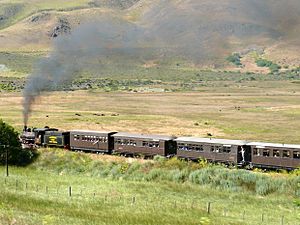
In the 1960s and 1970s, other railway lines in Patagonia started to close. La Trochita also began to face problems. Roads improved, and trucks and buses became more common. It was also hard to maintain the railway because it was so far from major cities.
However, during this time, tourists began to discover Patagonia. La Trochita became a popular attraction for travelers. Paul Theroux's book in 1978 made it even more famous. He gave it the nickname "The Old Patagonian Express," which captured its timeless charm.
Despite its popularity, the railway was not making money. In 1992, the government decided to close the line. But people from Argentina and around the world protested. They wanted to save this special railway. So, the two local governments worked together to keep La Trochita running.
La Trochita Today
Today, La Trochita still uses its original steam locomotives from 1922. It has 22 of these engines, made by Henschel and Baldwin. Seven of them can still run. These locomotives use oil for fuel and have been working for many years. There are no modern diesel engines on this line.
The train no longer runs the full distance between Esquel and El Maitén. Instead, there are two shorter tourist trips:
- One trip goes from Esquel to Nahuel Pan.
- The other goes from El Maitén to Desvío Thomae.
The journey from Esquel to El Maitén used to take almost seven hours. Now, the tourist trips are much shorter, often about an hour for a round trip. In 2010, tickets for tourists cost ARS$150 (Argentine Pesos) for a round trip. Residents of Argentina got a discount.
Keeping the old 1922 locomotives working is a challenge. It's hard to find parts and people with the right skills. This can sometimes cause delays or temporary shutdowns.
In 1999, the Government of Argentina declared La Trochita a National Historic Monument. This means it is protected for its historical importance. In 2003, a group called "Friends of La Trochita Association" was formed to support the railway.
In May 2011, strong winds caused an accident. The roof of one car blew off, causing the train to derail. Luckily, no one was seriously hurt, and the train was repaired.
Gallery
See also
 In Spanish: La Trochita para niños
In Spanish: La Trochita para niños
- List of heritage railways



